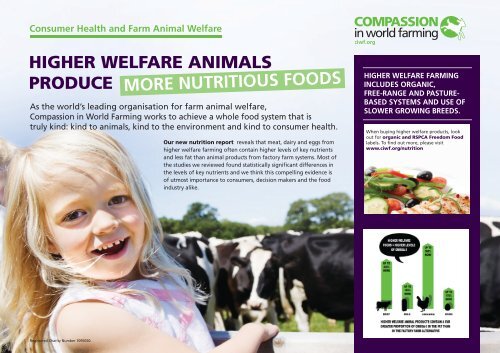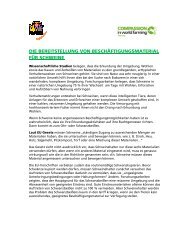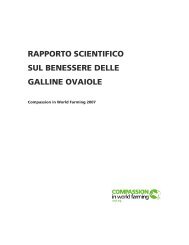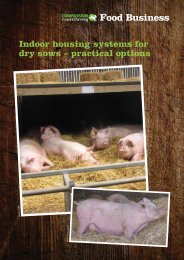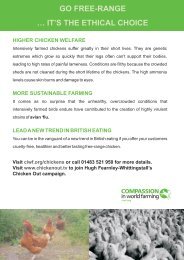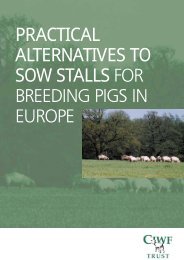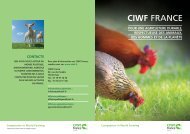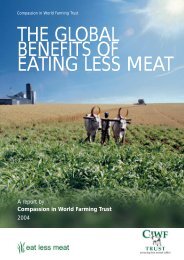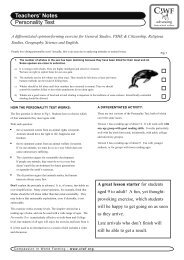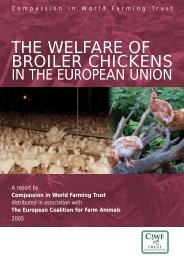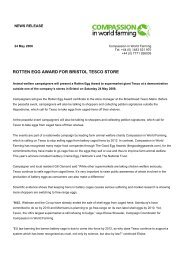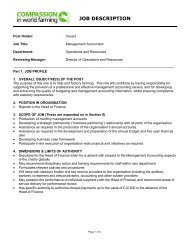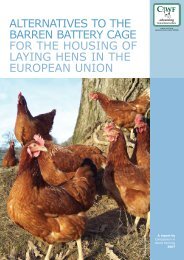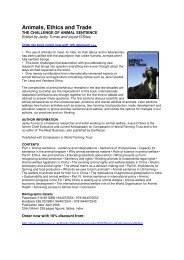Nutritional Benefits of Higher Welfare Animal Products
Nutritional Benefits of Higher Welfare Animal Products
Nutritional Benefits of Higher Welfare Animal Products
Create successful ePaper yourself
Turn your PDF publications into a flip-book with our unique Google optimized e-Paper software.
Consumer Health and Farm <strong>Animal</strong> <strong>Welfare</strong>HIGHER WELFARE ANIMALSPRODUCEMORE NUTRITIOUS FOODSAs the world’s leading organisation for farm animal welfare,Compassion in World Farming works to achieve a whole food system that istruly kind: kind to animals, kind to the environment and kind to consumer health.Our new nutrition report reveals that meat, dairy and eggs fromhigher welfare farming <strong>of</strong>ten contain higher levels <strong>of</strong> key nutrientsand less fat than animal products from factory farm systems. Most <strong>of</strong>the studies we reviewed found statistically significant differences inthe levels <strong>of</strong> key nutrients and we think this compelling evidence is<strong>of</strong> utmost importance to consumers, decision makers and the foodindustry alike.HIGHER WELFARE FARMINGINCLUDES ORGANIC,FREE-RANGE AND PASTURE-BASED SYSTEMS AND USE OFSLOWER GROWING BREEDS.When buying higher welfare products, lookout for organic and RSPCA Freedom Foodlabels. To find out more, please visitwww.ciwf.org/nutritionRegistered Charity Number 1095050.
Here are four <strong>of</strong> Compassion’s key findings:Photo © Getty imagesHIGHER WELFARE =LOWER FATCONTENTHIGHER WELFARE =HIGHER LEVELSOF OMEGA 3HIGHER WELFARE =HIGHER LEVELSOF ANTIOXIDANTSA LIFE WORTH LIVING =FOOD WORTHEATINGBy opting for higher welfare animal productsrather than factory farmed ones, consumerscould significantly reduce their dietary intake <strong>of</strong>fat, including saturated fat:• Free-range & organic chicken – up to 50%less fat• Slower-growing chicken – up to 65% less fat• Pasture-reared beef – 25% - 50% less fatObesity and its related health problems are onthe rise. It is known to contribute to cancer andheart disease – the world’s biggest killers –driving many consumers to choose healthierfoods. Compassion’s new report, therefore,could have pr<strong>of</strong>ound implications for bothconsumer health and the way animal productsare marketed to health-conscious consumers.Modern diets are <strong>of</strong>ten chronically lacking inOmega-3 fatty acids yet excessive in Omega-6 – animbalance that a number <strong>of</strong> researchers link toserious diseases such as heart disease and cancer,amongst others. Our new report demonstratesthat higher welfare animal products consistentlycontain a higher proportion <strong>of</strong> Omega-3 in theirfat than factory farmed animal products:• Pasture-reared beef – up to 430% higher• <strong>Higher</strong> welfare chicken – up to 565% higher• <strong>Higher</strong> welfare eggs – up to 170% higher• Pasture raised lamb - 30% to 245% higher• Pasture produced milk – 50% to 185% higher• <strong>Higher</strong> welfare pig meat – up to 290% higherBy having more opportunities to buy pasturerearedlamb and beef, slower-growingchicken and free-range eggs, consumers canbenefit from a substantial contributiontowards their dietary requirements for longchain Omega-3, whilst achieving a morebalanced intake <strong>of</strong> Omega-3 and Omega-6.<strong>Higher</strong> levels <strong>of</strong> antioxidants, which are vital togood health and help fight diseases such ascancer, were found in higher welfare animalproducts compared to those from intensivefactory systems:• Free-range eggs – up to 100% more vitamin E& 280% more beta-carotene• Free-range pig meat – up to 200% morevitamin E• <strong>Higher</strong> welfare beef – 335% to 700% morebeta-carotene• <strong>Higher</strong> welfare milk – 60% to 436% morebeta-caroteneBy choosing higher welfare animal products,consumers can contribute favourably towardstheir intake <strong>of</strong> vitamin E – an importantantioxidant. Given the health benefits <strong>of</strong>antioxidants in neutralising free-radicals andworking to prevent cancer, we consider thesefindings too significant to overlook.Farm animals are sentient beings with the fullcapacity to experience both wellbeing and suffering.In the drive for cheap animal protein, billions <strong>of</strong>animals endure the barren confinement <strong>of</strong> factoryfarming systems. Overcrowded, vulnerable to diseaseand denied basic needs, they have little or noopportunity to exercise or to express importantnatural behaviours and are <strong>of</strong>ten pushed to theirphysiological limits in the pursuit <strong>of</strong> ever-higher yields.The industrial farming model is unsustainable andrelentless in its exploitation <strong>of</strong> animals, land, energyand water. An urgent move from intensive towardshigher welfare farming is required to improveanimal welfare, as well as to reduce environmentalpollution and waste.<strong>Higher</strong> welfare farming produces healthier meat,eggs and milk than similar products from factoryfarms. Switching from factory farmed animalproducts to higher welfare could contribute toimproved consumer health, especially if consumedin moderation within a balanced diet, rich in fruitand vegetables.Meat, milk and eggs from higher welfare farming systems can be better for our health than intensively produced products because they tend to have• LESS FAT • A GREATER PROPORTION OF OMEGA-3 • HIGHER LEVELS OF ANTIOXIDANTS.The findings <strong>of</strong> over 200 studies were examined and data from the 76 most robust studies were analysed in detail.Please read our full report online, ciwf.org/nutritionTo support the move towards higher welfare farming, please visit ciwf.org/help_us


